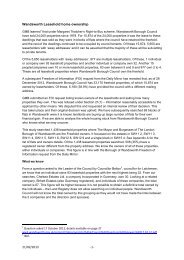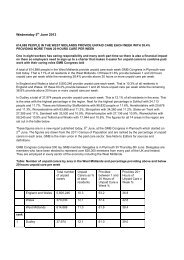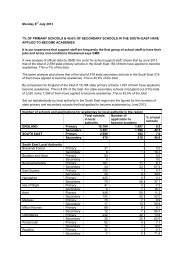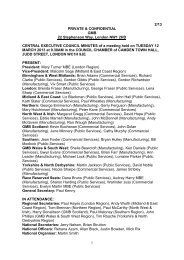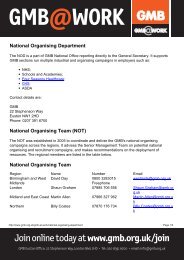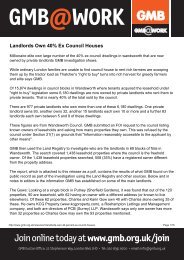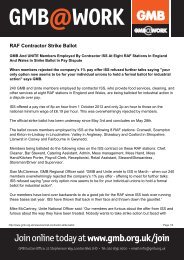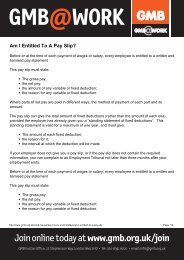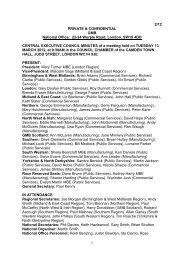WO toolkit 2012 complete.pdf - GMB
WO toolkit 2012 complete.pdf - GMB
WO toolkit 2012 complete.pdf - GMB
You also want an ePaper? Increase the reach of your titles
YUMPU automatically turns print PDFs into web optimized ePapers that Google loves.
SECTION 4.4<br />
DEALING WITH MEMBERS’GRIEVANCES<br />
Your employer should have a grievance procedure for individual problems.<br />
A member or members with a grievance against management will expect your help if they cannot sort<br />
the issue out themselves with line management.Make sure you are familiar with the grievance<br />
procedure where you work and that the member understands that this has to be followed.<br />
You will submit any grievance on behalf of your member and seek a meeting for the grievance to be<br />
heard.<br />
Make sure your grievance letter is short and to the point.It should refer to the relevant sections of<br />
the procedure.Avoid going into the detail of your member’s case.<br />
Arrange a meeting in work time that is convenient for your member and gives you time to prepare.The<br />
meeting should be arranged within the time limits set in your employer’s written procedure.If any<br />
move is made by your employer to postpone a hearing ask for a full written explanation of the reasons<br />
and,if you accept the reason,agree a new date.<br />
A sample grievance letter can be found at the end of this section.<br />
BEFORE THE HEARING<br />
You should also make sure that you have a copy of the member’s contract of employment/written<br />
statement of terms and conditions to hand and all other material that supports the case.<br />
It is vital when handling either grievance or disciplinary issues that you begin by establishing the facts.<br />
You must avoid meeting management when they are better informed than you are.Take the member(s)<br />
involved to a private place,preferably the trade union office(individual matters should always be dealt<br />
with on a confidential basis and you should not discuss them with anybody who is not involved).<br />
SPECIFICALLY YOU NEED TO ESTABLISH<br />
• The exact nature of the problem.<br />
• The names of the people involved.<br />
• Exactly when the problem occurred,not‘about a week ago’but the exact date and time.<br />
• Exactly how many times the problem has occurred,not‘a lot’but the number of times.<br />
Having established the facts you will have to exercise your judgement.Questions you must satisfy<br />
yourself about include:<br />
• Is the grievance valid?<br />
• Are current agreements being followed?<br />
• Is the law being broken?<br />
• Are there health and safety implications?<br />
If you decide that the situation warrants further action you must consult the member(s)involved and<br />
ensure that they understand the consequences of taking the matter further,both if the matter is<br />
resolved in their favour and if it is not.To do this you yourself must have a thorough understanding of<br />
your grievance procedure,so study it in advance.As a general rule the pressure for action should be<br />
coming from the member(s),not from you.<br />
You must also be satisfied that the grievance is valid.You are not obliged to represent members in<br />
pursuing invalid grievances,you will undermine your credibility with management if you do.<br />
You should then prepare your arguments and identify your aims in a methodical way,specifically:<br />
• Which events clearly illustrate the nature of the problem? Try to select incidents which are simple<br />
to explain.<br />
• What are your members aims? Try to have some idea of the minimum acceptable outcome.



